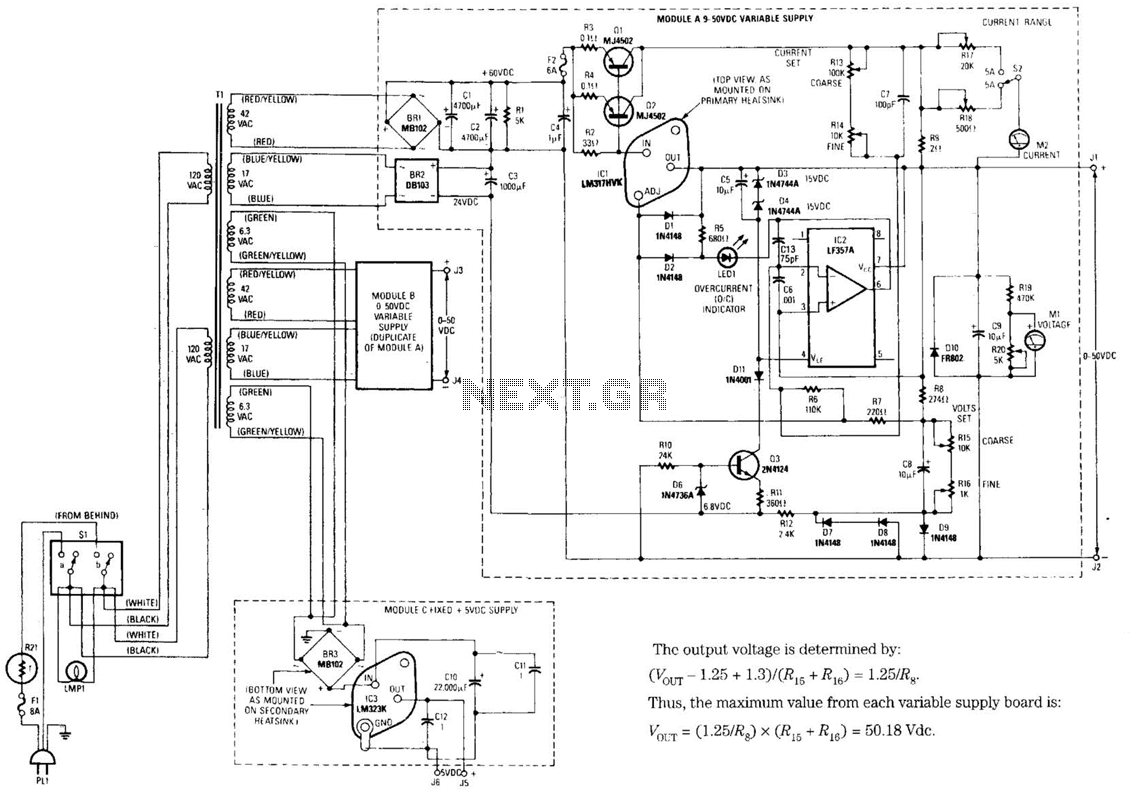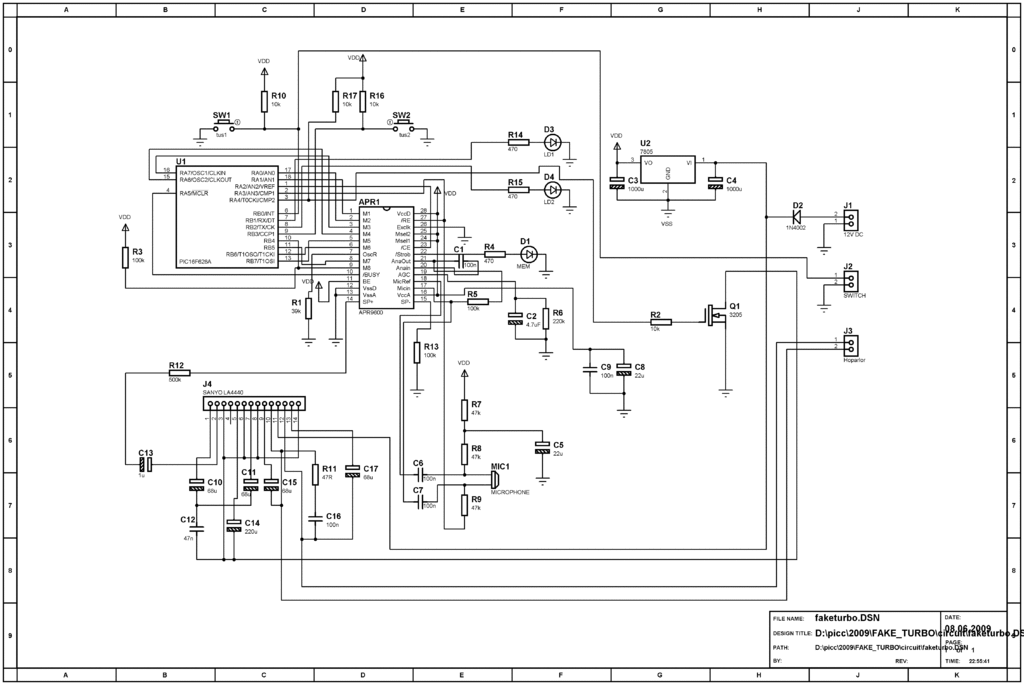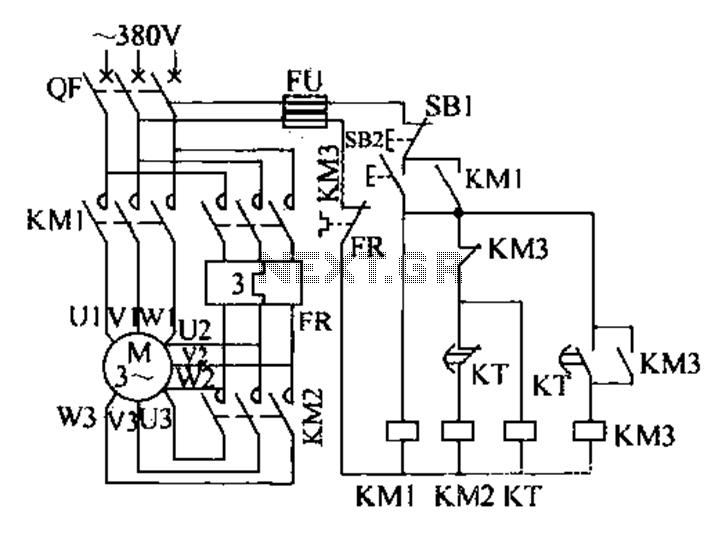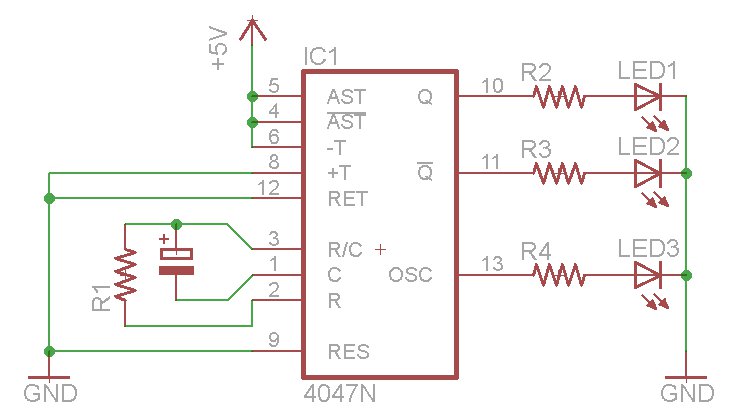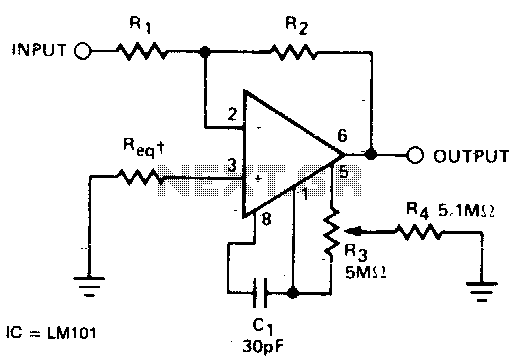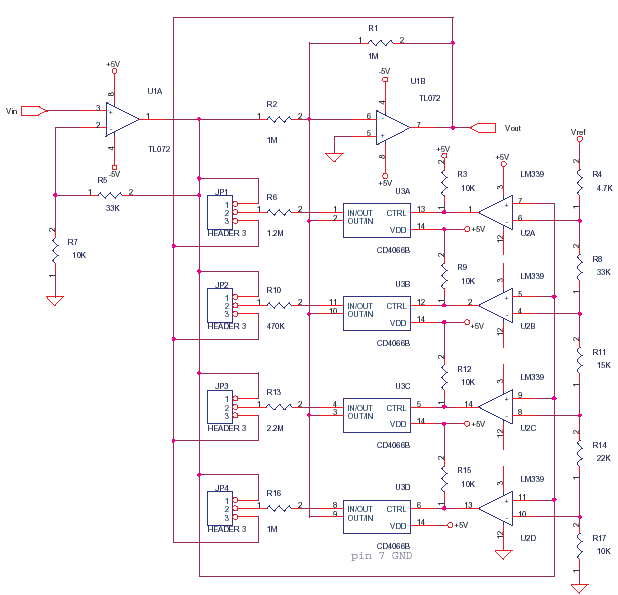
Laser Pointer Remote Control Circuit
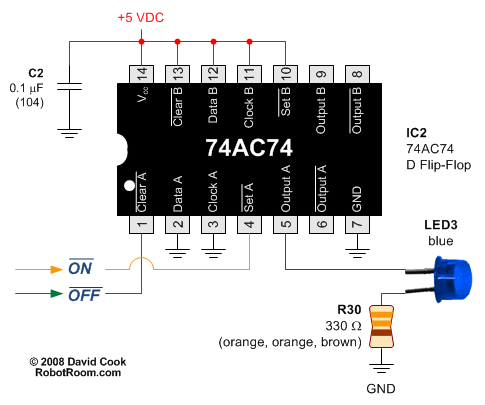
The laser-pointer detection circuitry is capable of identifying when a laser light is directed at a specific photosensor. If the laser targets the top sensor, the comparator chip outputs a high signal. Conversely, if the laser is aimed at the bottom sensor, the comparator chip outputs a low signal. The circuit can function as intended if activation is desired only while the laser is focused on the active sensor. However, to retain the memory of which sensor was last activated, it is necessary to connect those outputs to a memory chip. In the schematic, the output labels of "on" and "off" are marked with a line above them, indicating that the output is low (0V) when the condition is true, which signifies a negated output. This configuration has been implemented to meet the requirements of the memory chip, which requires information in this format. For circuits that require conventional outputs, swapping specific pins on the comparator will yield the desired output. The circuit's memory requirement is minimal, needing only to remember whether the output should be high (5V) or low (0V). This basic memory is referred to as a bit, representing a binary digit that can only be in one of two states. The 7474 chip serves as a fundamental logic chip containing a 1-bit memory cell, with the 7474 variant providing two independent memory cells on a single chip. In this circuit, only one bit is utilized, leaving the other half of the chip unused. To prevent noise interference, the unused inputs should be tied to 5V. It is critical not to connect these pins to ground, as this would violate logical constraints. When the "on" sensor output is low, it sets the output of the IC2 to high, energizing the blue LED (LED3) through a current-limiting resistor (R30). If the "off" sensor output is low, it clears the IC2 output to low, resulting in no current flow through the LED, thus preventing it from lighting. The 74AC74 chip retains the last state of the output, while other unused pins offer advanced memory capabilities. This configuration is classified as an SR latch rather than a full D-type flip-flop. Additionally, the 74AC74 chip can provide greater output current than the comparator chip, rated at 24mA at 4V with a 5V supply, sufficient for LED operation. The selected component is the Texas Instruments SN74AC74N, which follows the standard 7474 pin layout and functionality, with specific letters denoting the manufacturer and chip characteristics.
The laser-pointer detection circuit employs a comparator chip to discern between two photosensors. The use of a high (5V) output when the top sensor is activated and a low (0V) output when the bottom sensor is activated allows for a straightforward logic operation. The circuit's design facilitates a memory function by incorporating a 7474 flip-flop, which retains the last state of the output, enabling it to remember whether the LED should be illuminated or not based on the most recent sensor activation.
The 7474 flip-flop, which consists of two independent 1-bit memory cells, serves as the core memory component of the circuit. This dual functionality allows for potential expansion or more complex operations in future designs. The unused cell on the chip is effectively managed by tying its inputs to a stable high voltage, ensuring that noise does not inadvertently affect circuit performance.
The output stage of the circuit is designed to drive an LED, with the inclusion of a current-limiting resistor to prevent excessive current flow that could damage the LED. The choice of the Texas Instruments SN74AC74N chip is particularly beneficial due to its ability to handle higher output currents compared to the comparator, ensuring reliable operation of the LED under varying conditions.
This circuit exemplifies a basic yet effective application of digital logic components to create a functional memory-based detection system. By leveraging the capabilities of the comparator and the flip-flop, the design achieves both immediate responsiveness to sensor input and the ability to retain state information, making it suitable for a variety of applications in laser detection and control systems.The laser-pointer detection circuitry is able to determine when a laser light is aimed at a particular photosensor. If the laser is aimed at the top sensor, the comparator chip outputs on . If the laser is aimed at the bottom sensor, the comparator chip outputs off . The circuit could be considered complete if you wanted somethi ng to be turned on only while the laser is aimed at the on sensor. However, if you want the circuit to remember whether the on sensor or the off sensor was most recently selected, then you`re going to need to hook those outputs to a memory chip. Looking back at the schematic, you`ll notice that the output names of on and off have little lines above the words.
Usually an output is high (5V) when a condition is true, but the line above the word means the output is low (0V) when the condition is true. The line stands for opposite , not , or negate . The reason that the comparator has been wired to do this is because the memory chip on this page needs the information in that format.
However, should you have a circuit that needs normal outputs, simple swap IC1 pin 5 with IC1 pin 6, and IC1 pin 2 with IC1 pin 3. Flipping the input pins on the comparator provides the opposite output. This circuit only needs to remember whether the final output should be on (5V) or off (0V). This is the smallest, most rudimentary amount of memory. It is called a bit ; which stands for binary digit . A bit can only be on or off. The 7474 chip is a basic logic chip that contains a 1-bit memory cell. For convenience, just like the comparator chip on the previous page, the 7474 includes two independent copies of this feature on a single chip.
Therefore, the 7474 has two independent 1-bit memories on the chip. We only need one bit for this circuit, so the top half of the schematic shows one side of the chip is unused. Tying those unused inputs to 5V prevents them from receiving random noise. (Don`t tie those pins to ground, because pins 10 and 13 on the 7474 chip aren`t logically permitted to be 0V at the same time).
If the on sensor output is low, it sets (pin 4) the IC2 output (pin 5) to high. A high output (5V) will provide power to the big blue LED (LED3). The blue LED is prevented from receiving too much current by a resistor (R30). If the off sensor output is low, it clears (pin 1) the IC2 output (pin 5) to low. Because the output is low (0V) and the other end of the LED-resistor pair is also low (connected to GND which is 0V), no current flows. LEDs only light up when current flows through them. Therefore, the LED doesn`t light up. The purpose of the 74AC74 chip is to remember whether it was last set or cleared. The other pins are not used in this circuit, but provide fancier memory techniques such as remembering the data input (pin 2) only when the clock (pin 3) goes from low to high.
By the way, this configuration of the chip is technically considered an SR latch (set-reset), as opposed to a full D-type flip-flop. Besides remembering the last state, the other valuable service this chip performs is outputting greater current than the comparator chip can.
In fact, this 74AC74 chip is rated at 24mA @ 4V when the chip is connected to a 5V supply. That`s plenty for an LED. The exact chip I selected is a Texas Instruments SN74AC74N. It has the standard 7474 pin layout and functionality. The extra letters provide a little more specific information. Chip manufacturers include letter prefixes to indicate that it came from their company. In this case, SN is the brand manufactured by Texas Instruments. Chip manufacturers include letter suffixes to indicate the type of package, guaranteed temperature range, legal compliance (hazardous materials), and whether it comes on a reel. In this case, the letter N at the end of the Texas Instruments part name says that it comes on a plastic DIP chip that is the right size for a solderless breadb
🔗 External reference
The laser-pointer detection circuit employs a comparator chip to discern between two photosensors. The use of a high (5V) output when the top sensor is activated and a low (0V) output when the bottom sensor is activated allows for a straightforward logic operation. The circuit's design facilitates a memory function by incorporating a 7474 flip-flop, which retains the last state of the output, enabling it to remember whether the LED should be illuminated or not based on the most recent sensor activation.
The 7474 flip-flop, which consists of two independent 1-bit memory cells, serves as the core memory component of the circuit. This dual functionality allows for potential expansion or more complex operations in future designs. The unused cell on the chip is effectively managed by tying its inputs to a stable high voltage, ensuring that noise does not inadvertently affect circuit performance.
The output stage of the circuit is designed to drive an LED, with the inclusion of a current-limiting resistor to prevent excessive current flow that could damage the LED. The choice of the Texas Instruments SN74AC74N chip is particularly beneficial due to its ability to handle higher output currents compared to the comparator, ensuring reliable operation of the LED under varying conditions.
This circuit exemplifies a basic yet effective application of digital logic components to create a functional memory-based detection system. By leveraging the capabilities of the comparator and the flip-flop, the design achieves both immediate responsiveness to sensor input and the ability to retain state information, making it suitable for a variety of applications in laser detection and control systems.The laser-pointer detection circuitry is able to determine when a laser light is aimed at a particular photosensor. If the laser is aimed at the top sensor, the comparator chip outputs on . If the laser is aimed at the bottom sensor, the comparator chip outputs off . The circuit could be considered complete if you wanted somethi ng to be turned on only while the laser is aimed at the on sensor. However, if you want the circuit to remember whether the on sensor or the off sensor was most recently selected, then you`re going to need to hook those outputs to a memory chip. Looking back at the schematic, you`ll notice that the output names of on and off have little lines above the words.
Usually an output is high (5V) when a condition is true, but the line above the word means the output is low (0V) when the condition is true. The line stands for opposite , not , or negate . The reason that the comparator has been wired to do this is because the memory chip on this page needs the information in that format.
However, should you have a circuit that needs normal outputs, simple swap IC1 pin 5 with IC1 pin 6, and IC1 pin 2 with IC1 pin 3. Flipping the input pins on the comparator provides the opposite output. This circuit only needs to remember whether the final output should be on (5V) or off (0V). This is the smallest, most rudimentary amount of memory. It is called a bit ; which stands for binary digit . A bit can only be on or off. The 7474 chip is a basic logic chip that contains a 1-bit memory cell. For convenience, just like the comparator chip on the previous page, the 7474 includes two independent copies of this feature on a single chip.
Therefore, the 7474 has two independent 1-bit memories on the chip. We only need one bit for this circuit, so the top half of the schematic shows one side of the chip is unused. Tying those unused inputs to 5V prevents them from receiving random noise. (Don`t tie those pins to ground, because pins 10 and 13 on the 7474 chip aren`t logically permitted to be 0V at the same time).
If the on sensor output is low, it sets (pin 4) the IC2 output (pin 5) to high. A high output (5V) will provide power to the big blue LED (LED3). The blue LED is prevented from receiving too much current by a resistor (R30). If the off sensor output is low, it clears (pin 1) the IC2 output (pin 5) to low. Because the output is low (0V) and the other end of the LED-resistor pair is also low (connected to GND which is 0V), no current flows. LEDs only light up when current flows through them. Therefore, the LED doesn`t light up. The purpose of the 74AC74 chip is to remember whether it was last set or cleared. The other pins are not used in this circuit, but provide fancier memory techniques such as remembering the data input (pin 2) only when the clock (pin 3) goes from low to high.
By the way, this configuration of the chip is technically considered an SR latch (set-reset), as opposed to a full D-type flip-flop. Besides remembering the last state, the other valuable service this chip performs is outputting greater current than the comparator chip can.
In fact, this 74AC74 chip is rated at 24mA @ 4V when the chip is connected to a 5V supply. That`s plenty for an LED. The exact chip I selected is a Texas Instruments SN74AC74N. It has the standard 7474 pin layout and functionality. The extra letters provide a little more specific information. Chip manufacturers include letter prefixes to indicate that it came from their company. In this case, SN is the brand manufactured by Texas Instruments. Chip manufacturers include letter suffixes to indicate the type of package, guaranteed temperature range, legal compliance (hazardous materials), and whether it comes on a reel. In this case, the letter N at the end of the Texas Instruments part name says that it comes on a plastic DIP chip that is the right size for a solderless breadb
🔗 External reference
